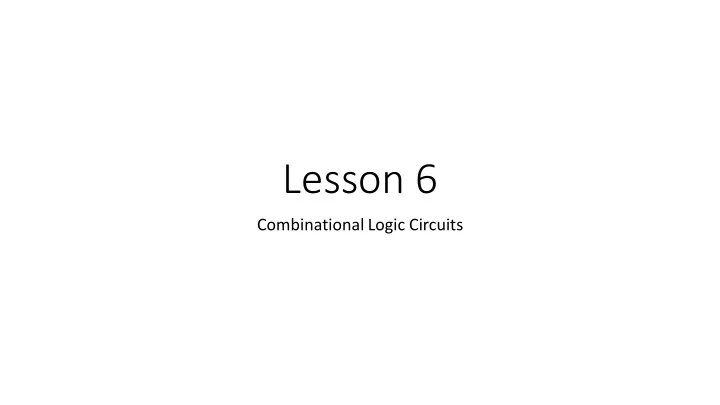

Lesson 6 Combinational Logic Circuits
Gate Review • AND Gate • OR Gate • NOT Gate • NAND Gate • NOR Gate
Gates and Integrated Circuits • Gates are not sold individually • They are sold in units called integrated circuits (ICs). • A chip is a small electronic device consisting of the necessary electronic components (transistors, resistors, and capacitors) to implement various gates.
Logic circuits • Digital logic chips are combined to produce circuits. • Logic circuits can be categorized as either o combinational logic o or sequential logic This lesson covers combinational logic.
Combinational Logic Circuit • Combining a number of basic logic gates in a larger circuit to produce more complex logical operations • A combinational logic circuit consists of logic gates whose outputs at any time are determined directly from the present combination of inputs without regard to previous inputs • Combinational circuit is a circuit in which we combine the different gates in the circuit, for example encoder, decoder, multiplexer and demultiplexer. • Combinational logic is used to build circuits that contain basic Boolean operators, inputs, and outputs. In a combinational circuit, an output is always based entirely on the given inputs.
Combinational Logic Circuit • Let us recall that Boolean algebra allows us to analyze and design digital circuits. • The output of a combinational circuit is a function of its inputs, and the output is uniquely determined by the values of the inputs at any given time • The following are some of the combinational circuits that we will discuss: half adders, full adders, multiplexers, demultiplexers, decoders,
Exclusive OR • Exclusive OR(Ex-OR) yields true if exactly one (but not both) of two conditions is true. • we know that for a 2-input OR gate, if A = 1, OR B = 1, OR both A + B = 1 then the output from the digital gate must also be at a logic level 1 • If however, a logic output 1 is obtained when only A = 1 or when ONLY B = 1 but NOT both together at the same time, giving the binary inputs of 01 or 10, then the output will be 1. This type of gate is known as an Exclusive-OR function
Truth Table for Ex-OR (XOR) A B A EX-OR B 0 0 0 0 1 1 1 0 1 1 1 0 The Boolean expression for A EX- OR B = AB’ + A’B ( A AND NOT B OR B AND NOT A)
EX-OR Symbol
Draw a circuit for AB’ + A’B •
Adders • An adder is a digital circuit that performs addition of numbers. • In many computers and other processors, adders are used in the arithmetic logic units or ALU. We will cover ALU on Wednesday. • In this lesson we cover half-adders and full-adders. Before we talk about adders we need to understand binary addition
Review on Binary Addition • Binary addition is much like your normal everyday addition (decimal addition), except that it carries on a value of 2 instead of a value of 10. • There are four rules of binary addition: 0 + 0 = 0 0 + 1 = 1 1 + 0 = 1 1 + 1 = 10 (which is 0 carry 1)
Example 1 • 1 + 11 = ? • Solution 1 + 11 If we take the first column from the right, we get the binary addition of 1 and 1, which is: 1 + 1 = 10 = 0 carry 1 The rightmost digit of our answer is therefore 0. • The second column from the right becomes: 0 + 1 + 1 (from the carry). In binary addition: 0 + 1 + 1 = 10 = 0 carry 1 • The second rightmost digit is a 0 and a 1 is carried to the next column. The next column doesn't exist (there are no numbers), therefore the 1 drops into the next slot of the answer. So our answer is: 1 0 0
Let us try the following problems • 1010 + 11 = ? • 100101 + 10101 = ?
Half-adder • A half-adder is a very simple combinational logic circuit with two inputs and two outputs • The half-adder can only add two bits together • The half adder adds two single binary digits A and B. It has two outputs, sum (S) and carry (C) • Consider adding two binary digits together: The three things to remember when adding binary digits are: o 0 + 0 = 0 o 0 + 1 = 1 + 0 = 1 o 1 + 1 = 10. • In the above there is a sum and carry at the outputs. Sum is an XOR. The Carry output is equivalent to that of an AND gate
Half-adder • The simplest half-adder design incorporates an XOR gate for S and an AND gate for C. Refer to the diagram in the next slide for more
Truth Table for a Half-Adder
The Logic Diagram for a Half-Adder
Full-adder • Full-adder is composed of two half-adders and an OR gate. • The full-adder is a three input and two output combinational circuit. • The first two inputs are A and B and the third input is an input carry as C-IN. • The output carry is designated as C-OUT and the normal output is designated as S which is SUM. • A full adder adds binary numbers and accounts for values carried in as well as out.
A Truth Table for a Full-Adder
A Logic Diagram for a Full-Adder
Rea eadin ing • Hennessy and Patterson Chapter 8.3 (Appendix B)
Recommend
More recommend